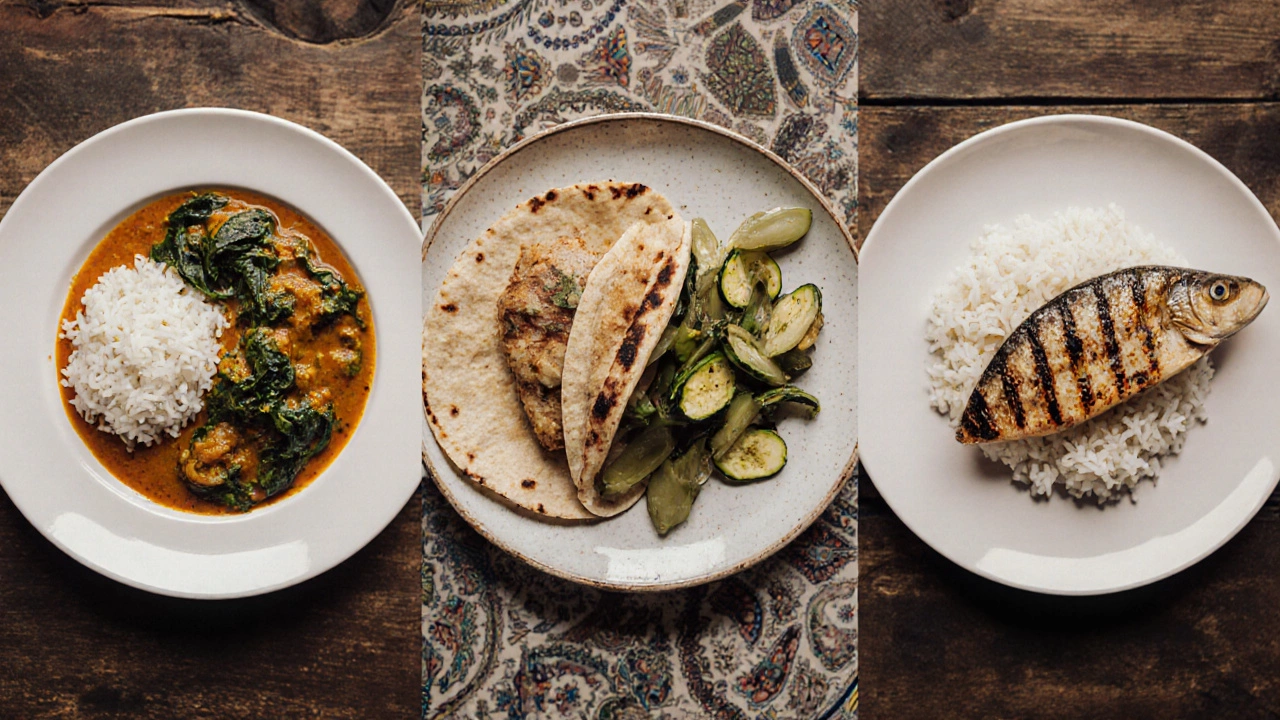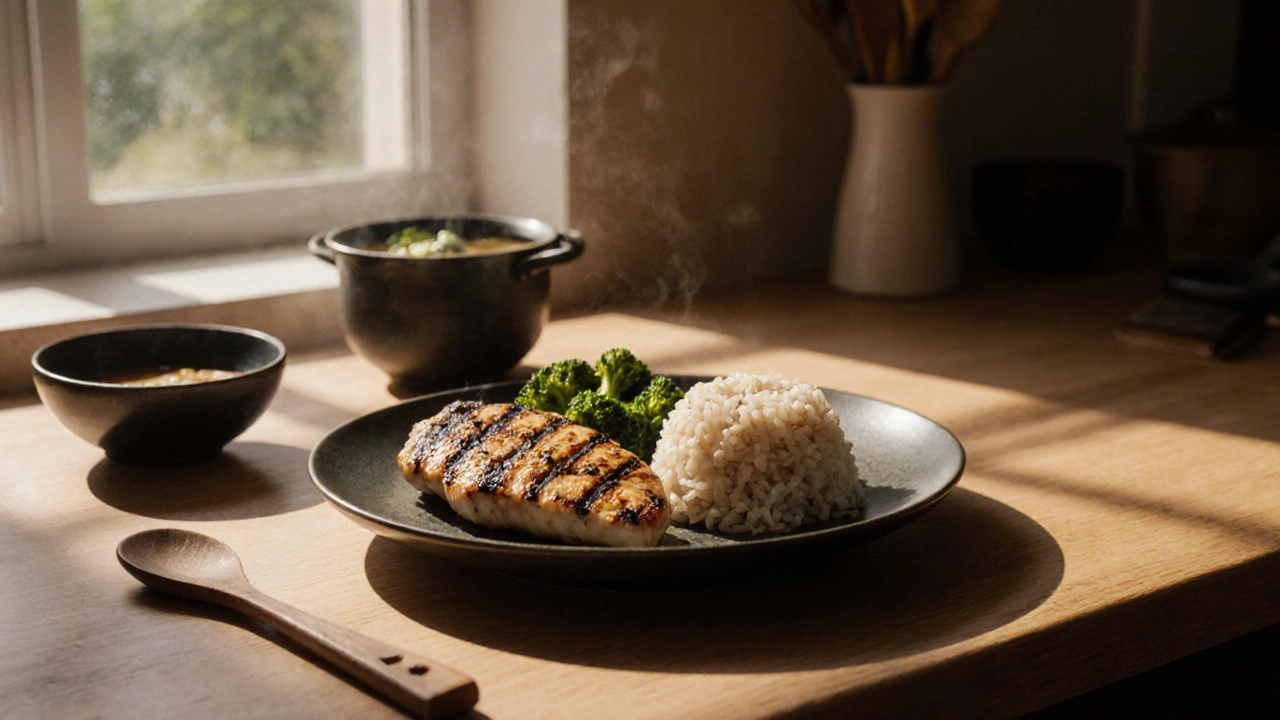Dinner Template Builder
The most common dinner worldwide follows the protein + starch + vegetables formula. This tool helps you build your own consistent dinner template based on the global standard.
Select your choices to see your personalized dinner template.
What do people actually eat for dinner every night? Not the fancy recipes you see on Instagram, not the meals from cooking shows, but the real, everyday plates that show up on tables from Tokyo to Toronto. If you’re trying to eat healthier, simplify your routine, or just figure out what normal looks like, knowing the most common dinner can help you stop overcomplicating things.
Chicken, Rice, and Vegetables Is the Real Global Standard
Forget gourmet plating. The most common dinner across cultures isn’t a fusion bowl or a plant-based burger. It’s a simple combo: protein, starch, and veggies. In the U.S., it’s grilled chicken, brown rice, and steamed broccoli. In Mexico, it’s chicken or beans with tortillas and sautéed zucchini. In India, it’s dal, rice, and spinach. In Japan, it’s grilled fish, white rice, and miso soup with pickled vegetables. In Nigeria, it’s stewed chicken or fish with pounded yam or rice. The pattern holds. No matter where you are, people cook one thing that gives them energy, one thing that fills them up, and one thing that keeps them healthy.
This isn’t just tradition-it’s practicality. Chicken is cheap, easy to cook, and lasts a few days. Rice and potatoes are shelf-stable, filling, and pair with almost anything. Vegetables? They’re the easiest way to sneak in nutrients without needing a recipe. You don’t need to be a chef to make this work. Just grab what’s fresh, cook the protein simply-grill, bake, or pan-sear-and toss the veggies in a bit of oil and salt. That’s it.
Why This Combo Works for Real Life
Most people don’t have two hours to cook after work. They don’t have a pantry full of exotic spices or the energy to experiment. They have a tired kid asking for food, a partner who’s hungry, and a fridge with leftovers from lunch. So they make what works: something quick, something filling, something that doesn’t require a grocery list longer than your arm.
A 2024 survey by the Global Food Institute found that 68% of households in 12 major countries prepare a version of this three-part dinner at least four nights a week. The top three proteins? Chicken, eggs, and beans. The top three carbs? Rice, pasta, and potatoes. The top three veggies? Broccoli, carrots, and spinach. That’s it. No kale smoothies, no quinoa bowls, no overnight fermented tofu. Just the basics, done well.
And here’s the truth: you don’t need to eat perfectly to eat well. A plate with grilled chicken, a cup of brown rice, and a side of roasted carrots gives you protein, fiber, complex carbs, and vitamins. That’s more than enough. You’re not failing if your dinner looks simple. You’re succeeding if it’s consistent.
What People Get Wrong About Healthy Dinners
There’s a myth that healthy eating means complicated meals. You see influencers posting rainbow bowls with chia seeds, hemp hearts, and turmeric dressing-and you think, “I can’t do that.” But real health isn’t about perfection. It’s about repetition. Eating the same simple, balanced meal five nights a week beats eating a perfect salad once and then ordering pizza the other four.
Another mistake? Over-relying on processed “healthy” foods. Pre-packaged grain bowls, frozen “low-carb” dinners, or protein bars masquerading as meals often have hidden sugars, sodium, and preservatives. They’re convenient, sure-but they’re not better than chicken, rice, and veggies cooked at home.
And then there’s the obsession with variety. You think you need 10 different dinner recipes to stay healthy. You don’t. You need one solid template and a few easy swaps. Swap chicken for eggs on Tuesday. Swap rice for sweet potato on Thursday. Swap broccoli for green beans on Friday. That’s variety enough. Your body doesn’t care if you ate the same thing three days in a row. It just cares that you ate real food.

How to Build Your Own Simple Dinner Template
Here’s how to make this work in your kitchen:
- Pick one protein you like and can afford. Chicken breast, ground turkey, eggs, tofu, lentils, or canned tuna. Buy it in bulk and cook a few portions at once.
- Pick one starch that keeps you full. Brown rice, whole-wheat pasta, quinoa, potatoes, or oats. Cook a big batch on Sunday and reheat it.
- Pick two veggies you actually like. Frozen is fine. Roast them with olive oil, salt, and pepper. Keep them in the fridge.
- Season simply. Salt, pepper, garlic powder, paprika, or a squeeze of lemon. You don’t need 12 spices.
That’s your template. Repeat it. Change one component each week. Add a dollop of yogurt or a sprinkle of cheese if you want. But don’t overthink it.
Real Examples From Real Kitchens
Here’s what actual dinners look like in Melbourne, Sydney, and beyond:
- Monday: Pan-seared chicken thighs, leftover rice from Sunday, steamed broccoli with soy sauce.
- Tuesday: Scrambled eggs with spinach, toast, and sliced tomato.
- Wednesday: Lentil curry with brown rice and frozen peas.
- Thursday: Baked salmon, mashed sweet potato, roasted carrots.
- Friday: Leftover stir-fry from last night’s takeout-just reheated with a side of plain rice.
No one’s posting these on Instagram. But these are the meals that keep families fed, energy levels steady, and stress levels low.
What to Do When You’re Tired or Short on Time
Some nights, you won’t even have time to chop a carrot. That’s okay. Here’s what to do:
- Keep canned beans in the pantry. Rinse them. Heat them with a pinch of cumin. Serve with microwave rice.
- Use frozen vegetables. They’re just as nutritious as fresh. Toss them in the oven while you cook your protein.
- Buy pre-cooked grilled chicken strips. Add them to a bag of pre-washed salad greens and a handful of roasted chickpeas.
- Make a big pot of soup or stew on the weekend. Freeze it in portions. Reheat with a slice of whole-grain bread.
You don’t need to cook from scratch every night. You just need to avoid the drive-thru.
Why This Matters for Long-Term Health
Diets fail because they’re unsustainable. You can’t live on kale smoothies and protein shakes forever. But you can live on chicken, rice, and veggies for the rest of your life-and feel great doing it.
Studies from the Harvard T.H. Chan School of Public Health show that people who eat a consistent, balanced plate of whole foods-protein, starch, and vegetables-have lower rates of obesity, type 2 diabetes, and heart disease than those who chase trendy diets. It’s not about what’s new. It’s about what’s steady.
When you stop chasing the perfect meal, you start eating better. When you stop comparing your dinner to someone else’s Instagram post, you start enjoying your food again.
So next time you’re standing in your kitchen wondering what to make, remember: you don’t need a new recipe. You need to trust the basics. Chicken, rice, veggies. That’s the most common dinner for a reason. It works.
Is chicken and rice really healthy for dinner?
Yes, if it’s balanced. Chicken provides lean protein, and brown rice gives you fiber and slow-digesting carbs. Add vegetables-like broccoli, spinach, or carrots-and you’ve got a complete, nutrient-rich meal. Skip the fried chicken and white rice, and you’re already ahead of most takeout options.
What if I don’t like chicken?
Swap it. Eggs, beans, lentils, tofu, canned tuna, or ground turkey all work the same way. The goal isn’t chicken-it’s protein. Pick one you enjoy and stick with it. Rotate every few weeks if you want variety, but don’t feel pressured to change every night.
Can I eat the same dinner every night?
You absolutely can-and many people do. Your body doesn’t need 10 different meals a week. It needs consistent nutrition. Eating the same healthy dinner five nights a week is far better than eating five different meals that are all processed or sugary. Just rotate your veggies or swap the protein occasionally to keep it interesting.
Are frozen vegetables as good as fresh ones?
Yes, often better. Frozen veggies are picked and flash-frozen at peak ripeness, locking in nutrients. Fresh veggies can lose vitamins during transport and storage. If you’re short on time or don’t want to waste food, frozen is a smart, healthy choice.
What’s the fastest way to make a healthy dinner?
Use pre-cooked proteins (like rotisserie chicken or canned beans), microwave rice or quinoa, and steam frozen veggies in the microwave for 4 minutes. Add salt, pepper, and a splash of soy sauce or lemon juice. Done in 10 minutes. No fancy tools needed.
Final Thought: Stop Overthinking, Start Eating
The most common dinner isn’t trendy. It’s not Instagrammable. It’s not expensive. But it’s the one that keeps people fed, healthy, and sane. You don’t need to be a nutritionist to eat well. You just need to show up. Cook the protein. Cook the rice. Cook the veggies. Repeat. That’s how real health happens-not in a single perfect meal, but in the quiet, ordinary rhythm of everyday eating.





